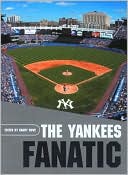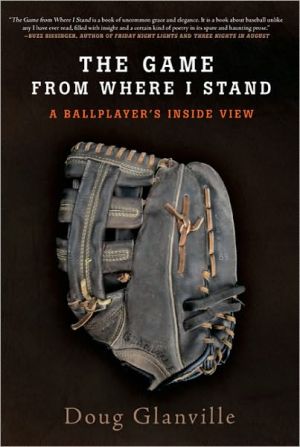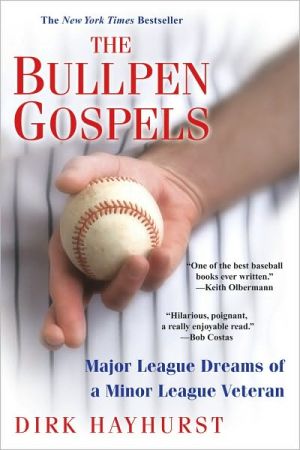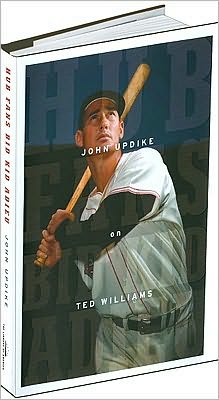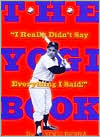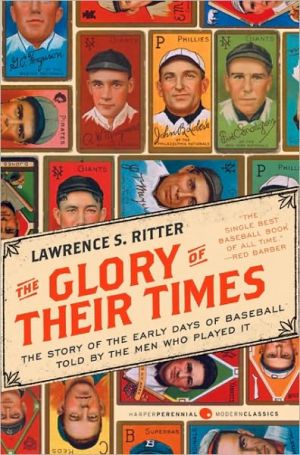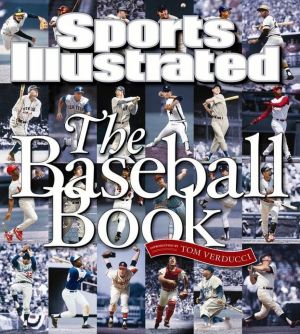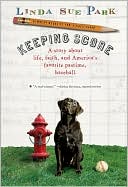The Only Game in Town: Baseball Stars of the 1930s and 1940s Talk about the Game They Loved (The Baseball Oral History Project, Vol. 1)
The 1930s was the era of such baseball legends as Babe Ruth, Lou Gehrig, Jimmie Foxx, Hank Greenberg, and Joe DiMaggio. In The Only Game in Town, pitcher Elden Auker recalls what it was like to face these sluggers, while Red Sox outfielder Dom DiMaggio remembers how he nearly ended his brother Joe's record hitting streak. Then, in the 1940s, baseball underwent tremendous change. First came World War II, and stars such as Bob Feller and future star Warren Spahn — both among the ten ballplayers...
Search in google:
The 1930s was the era of such baseball legends as Babe Ruth, Lou Gehrig, Jimmie Foxx, Hank Greenberg, and Joe DiMaggio. In The Only Game in Town, pitcher Elden Auker recalls what it was like to face these sluggers, while Red Sox outfielder Dom DiMaggio remembers how he nearly ended his brother Joe's record hitting streak. Then, in the 1940s, baseball underwent tremendous change. First came World War II, and stars such as Bob Feller and future star Warren Spahn — both among the ten ballplayers who discuss their playing days in this book — left the game to serve their country. When the war ended, integration came to baseball. Jackie Robinson was soon followed by other outstanding African-American ballplayers, including Larry Doby and Monte Irvin, both of whom recall their pioneering experiences in Major League Baseball. Buck O'Neil describes scouting and coaching the next generation of African-American ballplayers and helping them make it into the major leagues. Johnny Pesky and Tommy Henrich recall great Red Sox-Yankees rivalries, but from opposite sides, while Ralph Kiner remembers his remarkable ten-year stretch as the most feared home-run hitter of his day.The ten ballplayers who spoke with Fay Vincent for this fascinating book bring back to life baseball from a bygone time. Their stories make The Only Game in Town a must-have for all baseball fans. Publishers Weekly This first entry in an ambitious, multivolume oral history of baseball compiled by former commissioner Vincent collects the memories of 10 notable players from the 1930s and '40s. The tone is primarily upbeat, as when Dominic DiMaggio-one of the almost-as-talented but often forgotten brothers of Joe-sticks to the sunny side: "I think it's just a wonderful, wonderful game." The athletes have a forgivable tendency to ramble down memory lane and avoid deep analysis, often simply offering play-by-plays of famous games. Not surprisingly, then, it's the early integrators and Negro League pros like Larry Doby whose comments make the best reading; their stories have a drama and gravitas that some of the others lack. Vincent did not impose structure on his subjects, and there are a few redundancies in the narrative (although the twice-told story of Hank Greenberg storming into the White Sox locker room and calling out whoever made anti-Semitic remarks during the game is worth repeating). Dedicated fans stand to gain the most from this nostalgic spin through one slice of baseball history. (Apr.) Copyright 2006 Reed Business Information.
Introduction\ Some ten years ago a friend gave me a copy of the audiotapes that were the basis of Lawrence Ritter's book The Glory of Their Times. I was enthralled to listen to those old-time ballplayers talk about their experiences in our game around the turn of the twentieth century. Ritter made such a wonderful contribution to my understanding of the game in those days that I thought about emulating him with players from the 1930s and 1940s, who came along after those whom Ritter featured. One day I idly mentioned my idea to my good friend the estimable investment banker and great baseball fan Herbert Allen, who instantly encouraged me and pledged financial support if I would go out and do the interviewing. This book was born of that conversation.\ In checking with the National Baseball Hall of Fame, I learned there was no systematic oral history project being supported by that superb organization and so I undertook to fill that void. I was keenly aware that some important figures in the history of the integration of baseball, such as Larry Doby, were growing older and their stories would soon be lost forever. With that as motivation, I began this project. Herbert and I set up a tax-exempt foundation to provide some structure for our work, and we each gave money to support the interviewing and the necessary archival work at the Hall of Fame. (My thanks go to Steve Greenberg, treasurer of the foundation, for handling these financial matters.) We were joined by a third major contributor, George Cooney, whose video company, EUE Screen Gems, has provided gratis the camera crews and technical support to videotape every interview we have done. His help has been extraordinary and our gratitude is every bit as enormous as his generosity.\ In the years since we began this project, we have done close to forty interviews, and we have dozens more planned. For this book, we have selected players who were among the oldest of those we interviewed. The focus of this volume is on the integration of the major leagues. We chose interviews with Buck O'Neil and Elden Auker, two remarkable men who played their careers prior to integration, and we include Larry Doby and Monte Irvin to capture the coming of players of color to their rightful place in the game.\ The stories of Bob Feller, Dom DiMaggio, and Warren Spahn cover the World War II years and remind us of the amount of time those men and other ballplayers lost in their baseball careers by serving their country. Tommy Henrich is one of the few ballplayers alive from those great Yankee teams of the 1930s and 1940s, while Johnny Pesky recalls his years with the Boston Red Sox, playing alongside Ted Williams among others. Ralph Kiner tells of baseball in the glory days right after the war, when integration took hold.\ In conducting many of the interviews, including our first one with Larry Doby, I was the partner of the gifted baseball writer Claire Smith, whose contribution to this oral history project cannot be overstated. She has been a thoughtful and wise counselor and I thank her with all my heart. Others have done some interviewing and I thank them as well. They include the late Leonard Koppett, Ed Randall, John Pessah, Mark Hyman, Dick Crago, and James Salisbury.\ To put together this book — which I hope will be the first of several volumes of baseball history — I was ably assisted by my Simon & Schuster editor, Bob Bender, who combed the transcripts of the interviews I conducted and arranged the ballplayers' comments into a narrative that I then edited. The Hall of Fame generously provided the photographs in this book, for which I thank Hall of Fame president, Dale Petroskey, and his colleagues Bill Burdick and Pat Kelly. Additional thanks to Jim Gates at the Hall of Fame. We paid a modest fee to each of the ballplayers whom we interviewed, and by agreement with them, any royalties earned from this book will go to the Hall of Fame, in recognition of its fine work in preserving and disseminating the history of baseball.\ In many ways this endeavor has been a labor of love for me. I have enjoyed hearing these great players describe their lives in baseball. In each interview, my first question was always the same: "Who got you interested in baseball? Who gave you your first ball and glove?" Inevitably, the next twenty or so minutes were filled by a delicious conversation. As the interviews grew, I was fascinated to discover that certain key events of the 1930s and 1940s were told — sometimes with small but significant differences — by more than one ballplayer. For example, both Elden Auker and Tommy Henrich tell the story of what happened when Hank Greenberg walked into the Chicago White Sox locker room after a game in which Greenberg had been insulted by anti-Semitic slurs from the White Sox bench. Because Auker was Greenberg's teammate at the time, his is the longer version of this story, but Henrich's account agrees in the key details. Compare Dom DiMaggio's and Johnny Pesky's accounts of Enos Slaughter's famous "dash to home" in Game 7 of the 1946 World Series. Each of them played a key role in that famous event, as you'll see. Warren Spahn tells the story of giving up Willie Mays's first hit on a pitch he was told Mays couldn't hit — but did, for a home run. Monte Irvin, Mays's teammate, tells the story from his vantage point. Everyone, it seems, has at least one Satchel Paige story (or one about Ted Williams or Joe DiMaggio), all of them colorful.\ It is my hope that you will enjoy these stories as I do because I am convinced that it is these stories that keep the history of baseball alive.\ — Fay Vincent\ Copyright © 2006 by The Baseball Oral History Project Foundation
Introduction 1Elden Auker 5Bob Feller 34Tommy Henrich 57John "Buck" O'Neil 80Dom DiMaggio 100Johnny Pesky 126Warren Spahn 143Larry Doby 171Ralph Kiner 193Monte Irvin 219Index 235
\ From Barnes & NoblePeople who think that baseball is only a game of hits and runs don't know the half of it. The diamond sport possesses a lore that transcends box scores and division standings. Former Commissioner of Baseball Fay Vincent captures the lure of that lore in this truly rousing collection of interviews with game greats from bygone days. Interviewees include Yogi Berra, Larry Doby, Ralph Kiner, Duke Snider, Frank Robinson, and Dom DiMaggio.\ \ \ \ \ Publishers WeeklyThis first entry in an ambitious, multivolume oral history of baseball compiled by former commissioner Vincent collects the memories of 10 notable players from the 1930s and '40s. The tone is primarily upbeat, as when Dominic DiMaggio-one of the almost-as-talented but often forgotten brothers of Joe-sticks to the sunny side: "I think it's just a wonderful, wonderful game." The athletes have a forgivable tendency to ramble down memory lane and avoid deep analysis, often simply offering play-by-plays of famous games. Not surprisingly, then, it's the early integrators and Negro League pros like Larry Doby whose comments make the best reading; their stories have a drama and gravitas that some of the others lack. Vincent did not impose structure on his subjects, and there are a few redundancies in the narrative (although the twice-told story of Hank Greenberg storming into the White Sox locker room and calling out whoever made anti-Semitic remarks during the game is worth repeating). Dedicated fans stand to gain the most from this nostalgic spin through one slice of baseball history. (Apr.) Copyright 2006 Reed Business Information.\ \ \ Library JournalThe former baseball commissioner delivers a series of interviews with ballplayers who played in the major leagues or the Negro leagues from the 1930s into the 1950s. Journeyman pitcher Elden Auker talks of teammate Hank Greenberg's battles against anti-Semitism, while legendary fireballer Bob Feller discusses his wartime service and his barnstorming with topflight African American players like Satchel Paige. Buck O'Neil discusses black baseball, hearkening back to Rube Foster, Martin Dihigo, and Oscar Charleston and the demise of the Negro Leagues. You'll also find Tommy Heinrich, Dom DiMaggio, and Warren Spahn, among others. For all baseball collections. Copyright 2006 Reed Business Information.\ \

